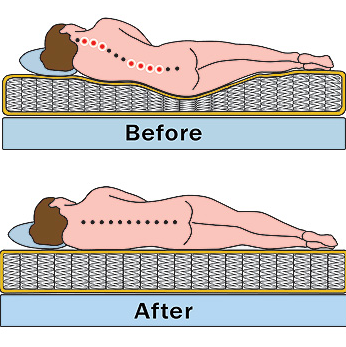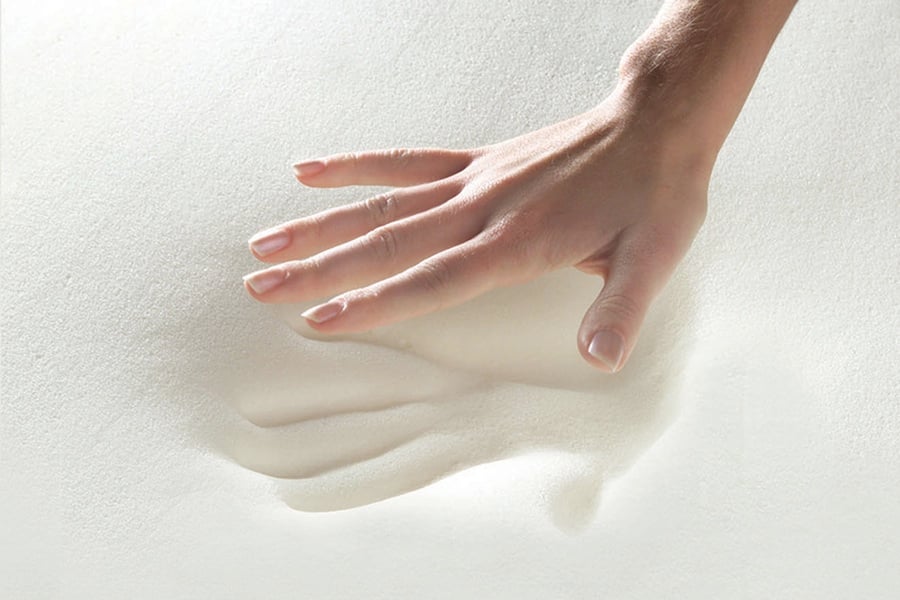Waking up with back pain isn't how anyone wants to start their day. When you can't seem to get comfortable and find yourself sleeping in uneven positions it usually because of a saggy or sunken mattress. It's not good for your sleep quality and it's not good for your muscles.
Related Blog: 5 Pros & Cons of Hard vs. Soft Mattresses
But why do mattresses sag? And more importantly, how can you fix it? Let's take a look at three of the leading causes of a sagging mattress and how to avoid them.
1. Sleeping Positions
Surprisingly, how and where you sleep can significantly affect the longevity and shape of your mattress. Whether you sleep alone, with your partner, or with a pet, these habits can lead to uneven pressure on specific points of the mattress. You might notice the most sagging around where your shoulders and hips rest.
Here are some signs that your sleeping position is the culprit:
- You sleep on one side of the mattress every night.
- You spoon or cuddle with your partner in one position all night.
- Your pet sleeps in one spot of your bed all night, every night.

How to fix it:
- Adjust Your Position: Changing your sleeping position or where you sleep on the mattress can help prevent concentrated areas of sag. Whether it's you and your partner, your pet, or just you, try to alternate to the other side occasionally.
- Check Your Mattress for Dents Every Month: Make it a habit to check the balance of your mattress at least once every month. That way, it's easier to notice when you have parts that are not flat enough and fix them early enough.
2. Inadequate Support
A lack of support from the bed frame or box spring can cause even the best mattresses to sag, especially in larger sizes like queen or king beds. It's wise to invest in quality beds and box springs.

Here's how to fix it:
- Check your bed frame and if any part of the bed is broken, repair it immediately to avoid creating dents in your mattress.
- Invest in a good-quality bed frame: Regular maintenance and investing in quality support structures are key to extending your mattress's life.
3. Wear and Tear
It's recommended that you get a new mattress every 8 years before they wear out. Whether it's latex, foam, or a spring mattress, the materials lose their strength with time. For instance, the springs might lose their firmness to bounce back when you sleep on them in traditional spring mattresses.
That will, in return, lead to the mattress sagging in such positions. As for the foam and latex mattresses, they can eventually become moldable as the materials compress from prolonged use.
But, if your mattress is sagging after only a year or 2, here's how to fix it:
- Rotating and Flipping: Regularly rotating your mattress can spread out the wear and tear and help maintain its shape. You can also flip your mattress at least every six months. The bottom side faces up and vice versa. Flipping the head to face the tail is also great. If your mattress wasn't designed to be flipped, turn or rotate the bed regularly.
- Additional Support: Consider using mattress toppers or adding a recommended box spring to provide extra support and delay the onset of sagging.

Consider a Mattress Replacement
If you've tried all the above tips and your mattress is still sagging, sinking, or has uncomfortable dents, then it's time to replace it. At Land of Sleep, we can help you find a durable mattress that fits all your sleep preferences.
Your sleep quality and health are too important to risk another sagging mattress, so make sure you check out our mattress cheat sheet so you can pick the highest quality mattress for your needs! Visit us at one of our store locations to get your best mattress yet!



